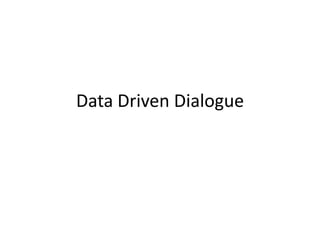
Data Driven Dialogue
- 2. Data Driven Dialogue • This protocol leads a team to begin by thinking of questions about student achievement. • National School Reform Faculty – Data Driven Dialogue • Article from ASCD, “Answering Questions That Count” December 2008/January 2009, pages 18-24. • Links to documents are on my web site
- 3. Getting Started • All participants have equal voice. • This will assist groups in making shared meaning of data. • Helps to replace hunches and feelings with data- based facts. • Examines patterns and trends of performance indicators. • Generate “root-cause” discussions that move from identifying symptoms to possible causes of student performance.
- 4. Overview • Phase I—Predictions – Surfacing perspectives, beliefs, assumptions, predictions, possibilities, questions and expectations. • Phase II—Observations – Analyzing the data for patterns, trends, surprises, and new questions that jump out. • Phase III—Inferences – Generating hypotheses, inferring, explaining and drawing conclusions. Defining new actions, interactions, and implementation plan.
- 5. Before You See the Data • Activate prior knowledge, surface assumptions, and make predictions to create a readiness to examine and discus the data. • Hear and honor all assumptions. • I assume …. • I predict …. • I wonder …. • My questions/expectations are influenced by … • Some possibilities for learning that this data may present ….
- 6. Consider • “When important questions drove the dialogue about school effectiveness, school staff quickly learned how to identify and use different types of data to answer those questions. (Lachat& Smith, 2004) • Organizing data around essential questions about student performance is a powerful strategy for building data literacy.
- 7. Possible Essential Questions • How do student outcomes differ by demographics, programs, and schools? • To what extent have specific programs, interventions, and services improved outcomes? • What is the longitudinal progress of a specific cohort of students? • What are the characteristics of students who achieve proficiency and of those who do not? • Where are we making the most progress in closing achievement gaps? • How do absence and mobility affect assessment results?
- 8. • How do student grades correlate with state assessment results and other measures? • What percent of the students improved, stayed the same or declined from last years achievement? • Are students making sufficient grade-to-grade progress? • How many of the lower performing students in grade 4 are still lower performing students in grade 5. • What is the variation in students’ scores within each course or grade.
- 9. • “Asking questions such as these enables administrators and teachers to focus on what is most important, identify the data they need to address their question, and use the questions as a lens for data analysis and interpretation.” P 18 • Limit the number of questions to no more than five or six crucial questions that get at the heart of what they need to know.
- 10. What is Needed? • Time to look at data, analyze data and ask more questions. • Time to look at the data rather than time spent creating the graphs and charts. • Teachers need opportunity and support to plan and implement improvement strategies and then collect data to see if the strategies work. • Opportunity to ask questions and then find data to answer the question. • Data that is sufficiently disaggregated – By broad categories, male, female, economic status, programs – Combinations of categories ie female and low SES
- 11. Phase II—Just the Facts • The terms; because, therefore, it seems, and however may not be used. • Use these sentence starters • I observe that …. • Some patterns/trends that I notice …. • I can count …. • I am surprised that I see ….
- 12. Phase III—Inferences • I believe that the data suggest …. Because … • Additional data that would help me verify/confirm my explanations is ….. • I think the following are appropriate solutions/responses that address the needs implied by the data …. • Additional data that would help guide implementation of the solutions/responses and determine if they are working ….